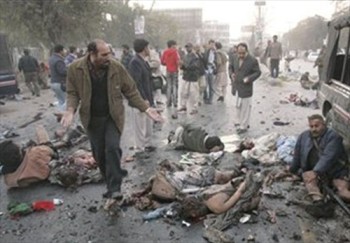
The dead and injured are seen after the attack that killed Pakistan's former Prime Minister Benazir Bhutto, in Rawalpindi, Pakistan, Thursday, Dec. 27, 2007. The scene depicts daylight, yet the AP "creation" time for this photo is 8:53 p.m., long after the 5:07 p.m. sundown, thus indicating the time stamp is in err. (AP Photo/B.K.Bangash)
Paul Colford, by phone, 2007: “I’m afraid we just don’t have the time to go into the particulars and the nuts and bolts of your request. It’s just that simple. We’re inundated with media requests all day long and at some point we just have to pick our shots, so I’m afraid I’m just not going to be able to go any further with this.”
Recently we went above Colford’s head to his boss and received this email response.
Colford wrote: “The time stamp or creation date can occasionally be inaccurate for a number of unintentional reasons – mechanical and otherwise.”
We followed up to ask how does he know that the AP time stamps are only “occasionally … inaccurate.”
Also we questioned why AP makes no disclosures that possible or actual errors exist in time stamps? Colford has declined to respond.
Since AP again confirms by email to iMediaEthics that they know their time stamps on the Bhutto crime scene — and others — are wrong. What do experts in media ethics think about their refusal to correct errors?
What Do Media Ethics Pros Think?
iMediaEthics consulted an array of experts in media studies and ethics, two focusing on traumatic events such as the Bhutto murder. Here are their email responses:
Kaleem Ahsan, who teaches journalism and political science at Bahria University, Islamabad, and is a photographer
“Journalism and truth go hand in hand. … …By this token, issuance of any photographic material by a journalistic organization with wrong or altered time stamps is definitely against all norms of responsible and ethical journalism. Such practice is a blur on the reputation, competence and professionalism of the organization. Time stamps record and communicate vital information as to at what time and after how long the reporter and photographer made it to the event site after its occurrence. Any alternation or change in the time stamp is against the basic tenets of journalism.”
Bill Kovach, Senior Counselor of the Project for Excellence in Journalism, co-author of The Elements of Journalism
“Without knowing all the details of your engagement with AP in this matter I have a couple of reactions to what you have shared with me.
“The first is that I suspect that Paul Colford might think you or any other independent press critic is easy for him to dismiss but I find it a serious problem for anyone associated with AP and especially someone in charge of ‘media relations’ not ‘to be bothered’ with the questions you raised because of ‘other priorities.’ What priorities at AP are higher and more demanding than truth and accuracy in their reporting— — verbal and pictorial?
“I have no experience with or knowledge of the problems Greg Payan discussed with you. But if they are unsure of the accuracy of the equipment upon which they depend they can at least control how they report on what the equipment tells them. They could set the time of creation as that ‘recorded by the camera.’ And it would be a simple matter and one that would take a few seconds to do the math in their own heads as to whether or not a photo they are looking at that appears to be full daylight was not taken an hour ago if it’s past midnight in the region.”
Kenny Irby, senior faculty, Visual Journalism & Diversity Programs, Poynter Institute
“The camera metadata option that produces time stamps is very much a double-edged dilemma. Time stamping without oversight, verification and attribution can be very misleading information. Albeit, time stamping with attention, accuracy and rigor can provide exceptionally valuable information. That said, metadata time stamps have to be authenticated and augmented with responsible reporting by the reporter/journalist.”
Bruce Shapiro, executive director, Dart Center for Journalism and Trauma, Columbia University Graduate School of Journalism
“It’s my impression that the AP and other major agencies strive for accuracy in these matters. Sometimes technology and circumstances cooperate. Sometimes they don’t. Since history will be constructed based on news photos as a primary source, I suppose agencies might note in their galleries that time stamps might not be accurate.”
Margaret A. Spratt, Ph.D, associate director / academic programs, Dart Center for Journalism and Trauma, University of Washington
“News professionals and organizations have an obvious ethical obligation to be both accurate and transparent. No photographic image fully captures the reality of a situation, so contextual information is crucial in providing viewers information. Accompanying text must be as accurate as possible. When mistakes are made — and mistakes are inevitable in high stress, fast moving, situations — they should be acknowledged and corrected.”
AP’s Policy on Corrections and Errors.
AP also refused to direct us to their time stamp or accuracy policy statements. We found them online: The Associated Press Statement of News Values and Principles:
“We insist on the highest standards of integrity and ethical behavior when we gather and deliver the news. That means we abhor inaccuracies, carelessness, bias or distortions.”
“When mistakes are made, they must be corrected – fully, quickly and ungrudgingly.”
Finally, AP policy states that “any failure to abide” by the policies “is subject to review, and could result in disciplinary action, ranging from admonishment to dismissal, depending on the gravity of the infraction.”
Who then will be held to account for such arrogance in knowing — but still continuing — to publish time stamps that obviously distort Pakistan’s history?
Disclosure: Kaleem Ahsan is a former professor of one of the co-authors of this report, Malik Ayub Sumbal. Malik took Ahsan’s editorial writing course from Jan. 2006 to Dec. 2007 at NUML University.
 AP Time Stamps got worse when Yahoo! News published them in 2007 |
UPDATE 1/23/2012 3:50 PM EST: Updated about cross-posting on the Express-Tribune. Postings will start this month.






Comments Terms and Conditions